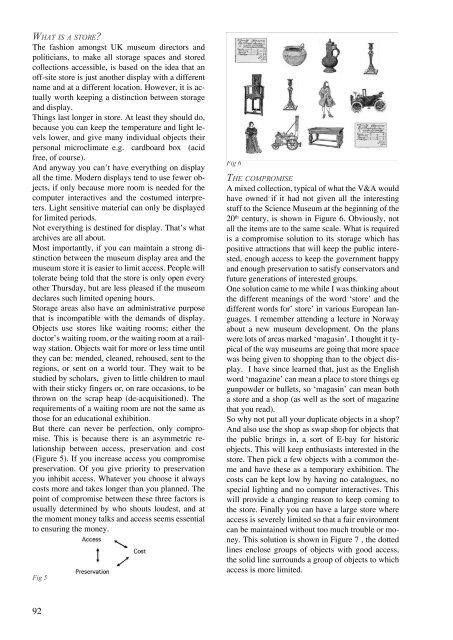pdf-fil (9,5Mb) - Nordisk Konservatorforbund Danmark
pdf-fil (9,5Mb) - Nordisk Konservatorforbund Danmark
pdf-fil (9,5Mb) - Nordisk Konservatorforbund Danmark
You also want an ePaper? Increase the reach of your titles
YUMPU automatically turns print PDFs into web optimized ePapers that Google loves.
WHAT IS A STORE?<br />
The fashion amongst UK museum directors and<br />
politicians, to make all storage spaces and stored<br />
collections accessible, is based on the idea that an<br />
off-site store is just another display with a different<br />
name and at a different location. However, it is actually<br />
worth keeping a distinction between storage<br />
and display.<br />
Things last longer in store. At least they should do,<br />
because you can keep the temperature and light levels<br />
lower, and give many individual objects their<br />
personal microclimate e.g. cardboard box (acid<br />
free, of course).<br />
And anyway you can’t have everything on display<br />
all the time. Modern displays tend to use fewer objects,<br />
if only because more room is needed for the<br />
computer interactives and the costumed interpreters.<br />
Light sensitive material can only be displayed<br />
for limited periods.<br />
Not everything is destined for display. That’s what<br />
archives are all about.<br />
Most importantly, if you can maintain a strong distinction<br />
between the museum display area and the<br />
museum store it is easier to limit access. People will<br />
tolerate being told that the store is only open every<br />
other Thursday, but are less pleased if the museum<br />
declares such limited opening hours.<br />
Storage areas also have an administrative purpose<br />
that is incompatible with the demands of display.<br />
Objects use stores like waiting rooms; either the<br />
doctor’s waiting room, or the waiting room at a railway<br />
station. Objects wait for more or less time until<br />
they can be: mended, cleaned, rehoused, sent to the<br />
regions, or sent on a world tour. They wait to be<br />
studied by scholars, given to little children to maul<br />
with their sticky fingers or, on rare occasions, to be<br />
thrown on the scrap heap (de-acquisitioned). The<br />
requirements of a waiting room are not the same as<br />
those for an educational exhibition.<br />
But there can never be perfection, only compromise.<br />
This is because there is an asymmetric relationship<br />
between access, preservation and cost<br />
(Figure 5). If you increase access you compromise<br />
preservation. Of you give priority to preservation<br />
you inhibit access. Whatever you choose it always<br />
costs more and takes longer than you planned. The<br />
point of compromise between these three factors is<br />
usually determined by who shouts loudest, and at<br />
the moment money talks and access seems essential<br />
to ensuring the money.<br />
Fig 5<br />
92<br />
Fig 6<br />
THE COMPROMISE<br />
A mixed collection, typical of what the V&A would<br />
have owned if it had not given all the interesting<br />
stuff to the Science Museum at the beginning of the<br />
20 th century, is shown in Figure 6. Obviously, not<br />
all the items are to the same scale. What is required<br />
is a compromise solution to its storage which has<br />
positive attractions that will keep the public interested,<br />
enough access to keep the government happy<br />
and enough preservation to satisfy conservators and<br />
future generations of interested groups.<br />
One solution came to me while I was thinking about<br />
the different meanings of the word ‘store’ and the<br />
different words for’ store’ in various European languages.<br />
I remember attending a lecture in Norway<br />
about a new museum development. On the plans<br />
were lots of areas marked ‘magasin’. I thought it typical<br />
of the way museums are going that more space<br />
was being given to shopping than to the object display.<br />
I have since learned that, just as the English<br />
word ‘magazine’ can mean a place to store things eg<br />
gunpowder or bullets, so ‘magasin’ can mean both<br />
a store and a shop (as well as the sort of magazine<br />
that you read).<br />
So why not put all your duplicate objects in a shop?<br />
And also use the shop as swap shop for objects that<br />
the public brings in, a sort of E-bay for historic<br />
objects. This will keep enthusiasts interested in the<br />
store. Then pick a few objects with a common theme<br />
and have these as a temporary exhibition. The<br />
costs can be kept low by having no catalogues, no<br />
special lighting and no computer interactives. This<br />
will provide a changing reason to keep coming to<br />
the store. Finally you can have a large store where<br />
access is severely limited so that a fair environment<br />
can be maintained without too much trouble or money.<br />
This solution is shown in Figure 7 , the dotted<br />
lines enclose groups of objects with good access,<br />
the solid line surrounds a group of objects to which<br />
access is more limited.
















